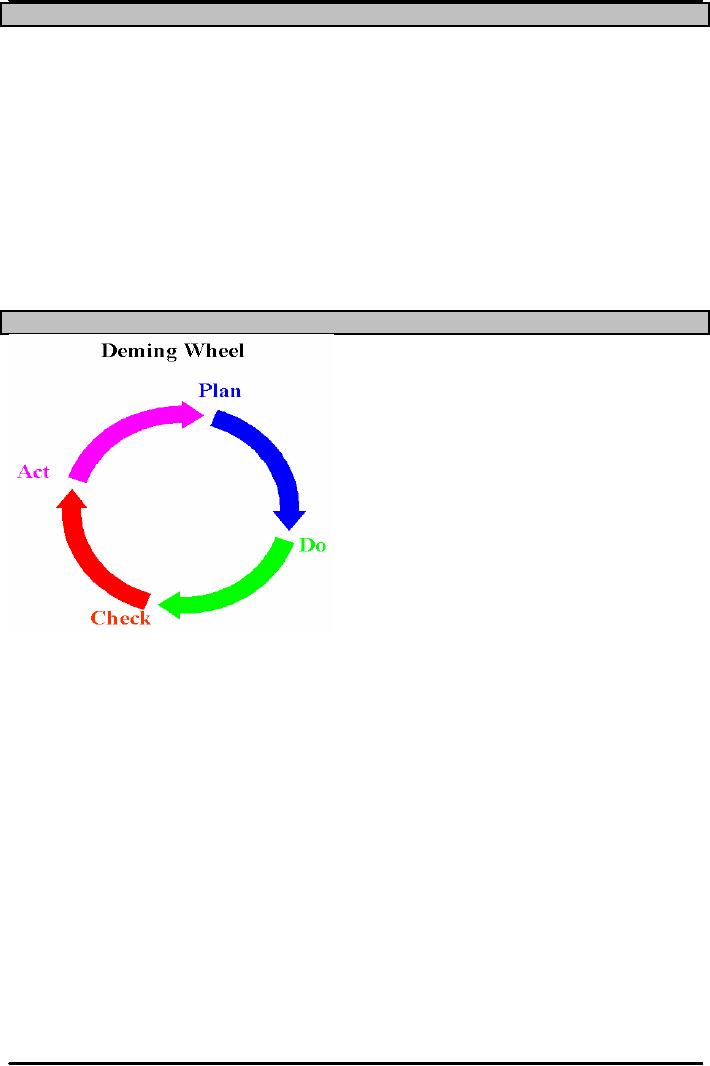 |
TQM QUALITY:Six Sigma Team, PROCESS IMPROVEMENT |
| << TOTAL QUALITY MANAGEMENT:Determinants of Quality, Responsibility for Quality |
| QUALITY CONTROL & QUALITY ASSURANCE:INSPECTION, Control Chart >> |

Production
and Operations Management
MGT613
VU
Lesson
26
TQM
QUALITY
In
this lecture we will look
into detail TQM. We will
initially focus on Six Sigma concept. We
will try
to
understand six sigma concept in
terms of managerial and
technical perspective. We will also
try to
understand
the Deming Wheel of Quality and
seven common tools of quality.
And last but not the
least
we
will also try to understand the
concepts of statistical process
control and benchmarking with
respect
to
quality.
ISO
CERTIFICATIONS
Quality
Certification ensures that the
organization has been able
to achieve TQM philosophy. The
two
popular
certifications which are
pursued by the organizations include
ISO 14000 and ISO
9000.
1.
ISO 14000: Is a set of
international standards for
assessing a company's
environmental
performance.
2.
ISO 9000: Is a set of
international standards on quality
management and quality
assurance,
critical
to international business.
SIX
SIGMA
Statistically
speaking a process is said to be in Six
Sigma stage if it does not have more
than 3 or 4
defects
per million. Most of the organizations,
measure their quality
program in terms of Six
Sigma.
Conceptually
the Six Sigma Program is designed to reduce
defects and requires the use of
certain tools
and
techniques.
Six
Sigma Programs are always
directed towards quality improvement,
cost cutting and time
saving. Six
Sigma
Programs are employed
in:
Design
Production
Service
Operation
management
Inventory
management
Delivery
Six
Sigma Management concepts find greater
appreciation and application in recent
times. The Six
Sigma
Management characteristics
include:
1.
Providing strong leadership.
2.
Defining performance merits.
3.
Selecting projects likely to
succeed.
4.
Selecting and training appropriate
people.
Six
Sigma Technical aspects form a
part and parcel of managerial strategy and
aids in cost cutting
and
defect
minimization. The Technical
aspects of Six Sigma
include
1.
Improving
process performance
2.
Reducing
variation
3.
Utilizing
statistical models
4.
Designing
a structured improvement strategy
116

Production
and Operations Management
MGT613
VU
Six
Sigma Team
Six
Sigma Teams are formed for
implement of Six Sigma in true
spirit keeping in mind both
managerial
as
well as technical
aspects.
1.
Top
management
2.
Program
champions
3.
Master
"black belts"
4.
"Black
belts"
5.
"Green
belts"
Six
Sigma Process
Six
Sigma Process has various
stages often organizations
combine one or two stages
for better
monitoring
and control purposes. Quality Experts
normally identify the following 5
stages.
1.
Define
2.
Measure
3.
Analyze
4.
Improve
5.
Control
Obstacles
to Implementing Six Sigma ( TQM)
includes the lack of:
1.
Company-wide definition of
quality.
2.
Strategic plan for
change.
3.
Customer focus.
4.
Real employee empowerment.
5.
Strong motivation.
6.
Time to devote to quality
initiatives.
7.
Leadership.
8.
Poor inter-organizational
communication.
9.
View of quality as a "quick
fix".
10.
Emphasis on short-term financial
results.
11.
Internal political and "turf"
wars.
Criticisms
of TQM
Blind
pursuit of TQM programs.
Programs
may not be linked to
strategies.
Quality-related
decisions may not be tied to
market performance.
Failure
to carefully plan a
program.
BASIC
STEPS IN PROBLEM
SOLVING
The
problem solving method is more or less
the same what we covered in the initial
part of our
semester,
we always try to follow the
same procedure or method which is to analyze the
problem and
then
generate pragmatic solutions
and implement the best
solution.
1.
Define the problem and establish an
improvement goal.
2.
Collect data
3.
Analyze the problem
4.
Generate potential solutions
5.
Choose a solution
6.
Implement the solution
7.
Monitor the solution to see if it
accomplishes the goal.
117

Production
and Operations Management
MGT613
VU
PROCESS
IMPROVEMENT
A
systematic approach to improving a
process would always result
in process improvement.
Following
are
the common approaches for improving the
process.
1.
Process mapping
2.
Analyze the process
3.
Redesign the process
Process
mapping consists mainly of
collecting information about the
process, identifying
the
process for each step and
determining the inputs and
outputs.
Analyze
the process: Ask questions about the
process including process
flow being logical,
any
activities or steps being missing or
identification of duplication
activities.
Questions
about each step which
includes is a particular step
necessary, does the step
adds
value,
does it generates waste,
could the time to perform the
step be reduced, could two
or
more
steps be combined.
Redesign
the process: takes a fresh approach to
solve an issue on hand.
THE
PDSA CYCLE (SHEWHART
CYCLE/DEMING WHEEL)
The
concept of the PDCA Cycle
was first introduced by
Walter Shewhart, the leading
statistician, who
also
developed statistical process
control in the Bell Laboratories in the
US during the 1930's. It is often
referred
to as `the Shewhart Cycle'. It was
taken up and promoted very
effectively from the 1950s on
by
the
famous Quality Management
authority, W. Edwards Deming, and is consequently
known by many
as
`the Deming Wheel'. It is a
continuous process and enables the
operations manager to check the
work
at
various stages.
The
PDCA Cycle is a checklist of the
four stages which you
must go through to get from
`problem-
faced'
to `problem solved'.
The
four stages of PDCA/Shewhart
Cycle or Deming Wheel
are:
1.
PLAN
Study
& Document the existing
process.
Collect
data to identify problems.
Survey
data and develop a plan for
improvement.
Specify
measures for evaluating the
plan.
2.
DO
Implement
the plan on a small
scale.
Document
any changes made during
this phase.
Collect
data systematically for
evaluation.
118

Production
and Operations Management
MGT613
VU
3.
CHECK
Evaluate
the data collection during
this phase.
Check
how closely the results
match the original goals of the plan
phase.
4.
ACT
If
the results are successful, standardize
the new method and communicate the
new
method
to all people associate with
the process.
Implement
training for the new
method.
If
results are unsuccessful, revise the
plan and repeat the process or
cease this project.
SEVEN
BASIC TOOLS
1.
Check Sheet
2.
Flow Chart
3.
Histogram
4.
Pareto Chart
5.
Scatter Diagram
6.
Cause & Effect
Diagram
7.
Statistical Process
Control
Quality
Circles
Team
approach
List
reduction
Balance
sheet
Paired
comparisons
Benchmarking
Process
Identify
a critical process that
needs improving.
Identify
an organization that excels in
this process.
Contact
that organization.
Analyze
the data.
Improve
the critical process.
119
Table of Contents:
- INTRODUCTION TO PRODUCTION AND OPERATIONS MANAGEMENT
- INTRODUCTION TO PRODUCTION AND OPERATIONS MANAGEMENT:Decision Making
- INTRODUCTION TO PRODUCTION AND OPERATIONS MANAGEMENT:Strategy
- INTRODUCTION TO PRODUCTION AND OPERATIONS MANAGEMENT:Service Delivery System
- INTRODUCTION TO PRODUCTION AND OPERATIONS MANAGEMENT:Productivity
- INTRODUCTION TO PRODUCTION AND OPERATIONS MANAGEMENT:The Decision Process
- INTRODUCTION TO PRODUCTION AND OPERATIONS MANAGEMENT:Demand Management
- Roadmap to the Lecture:Fundamental Types of Forecasts, Finer Classification of Forecasts
- Time Series Forecasts:Techniques for Averaging, Simple Moving Average Solution
- The formula for the moving average is:Exponential Smoothing Model, Common Nonlinear Trends
- The formula for the moving average is:Major factors in design strategy
- The formula for the moving average is:Standardization, Mass Customization
- The formula for the moving average is:DESIGN STRATEGIES
- The formula for the moving average is:Measuring Reliability, AVAILABILITY
- The formula for the moving average is:Learning Objectives, Capacity Planning
- The formula for the moving average is:Efficiency and Utilization, Evaluating Alternatives
- The formula for the moving average is:Evaluating Alternatives, Financial Analysis
- PROCESS SELECTION:Types of Operation, Intermittent Processing
- PROCESS SELECTION:Basic Layout Types, Advantages of Product Layout
- PROCESS SELECTION:Cellular Layouts, Facilities Layouts, Importance of Layout Decisions
- DESIGN OF WORK SYSTEMS:Job Design, Specialization, Methods Analysis
- LOCATION PLANNING AND ANALYSIS:MANAGING GLOBAL OPERATIONS, Regional Factors
- MANAGEMENT OF QUALITY:Dimensions of Quality, Examples of Service Quality
- SERVICE QUALITY:Moments of Truth, Perceived Service Quality, Service Gap Analysis
- TOTAL QUALITY MANAGEMENT:Determinants of Quality, Responsibility for Quality
- TQM QUALITY:Six Sigma Team, PROCESS IMPROVEMENT
- QUALITY CONTROL & QUALITY ASSURANCE:INSPECTION, Control Chart
- ACCEPTANCE SAMPLING:CHOOSING A PLAN, CONSUMER’S AND PRODUCER’S RISK
- AGGREGATE PLANNING:Demand and Capacity Options
- AGGREGATE PLANNING:Aggregate Planning Relationships, Master Scheduling
- INVENTORY MANAGEMENT:Objective of Inventory Control, Inventory Counting Systems
- INVENTORY MANAGEMENT:ABC Classification System, Cycle Counting
- INVENTORY MANAGEMENT:Economic Production Quantity Assumptions
- INVENTORY MANAGEMENT:Independent and Dependent Demand
- INVENTORY MANAGEMENT:Capacity Planning, Manufacturing Resource Planning
- JUST IN TIME PRODUCTION SYSTEMS:Organizational and Operational Strategies
- JUST IN TIME PRODUCTION SYSTEMS:Operational Benefits, Kanban Formula
- JUST IN TIME PRODUCTION SYSTEMS:Secondary Goals, Tiered Supplier Network
- SUPPLY CHAIN MANAGEMENT:Logistics, Distribution Requirements Planning
- SUPPLY CHAIN MANAGEMENT:Supply Chain Benefits and Drawbacks
- SCHEDULING:High-Volume Systems, Load Chart, Hungarian Method
- SEQUENCING:Assumptions to Priority Rules, Scheduling Service Operations
- PROJECT MANAGEMENT:Project Life Cycle, Work Breakdown Structure
- PROJECT MANAGEMENT:Computing Algorithm, Project Crashing, Risk Management
- Waiting Lines:Queuing Analysis, System Characteristics, Priority Model